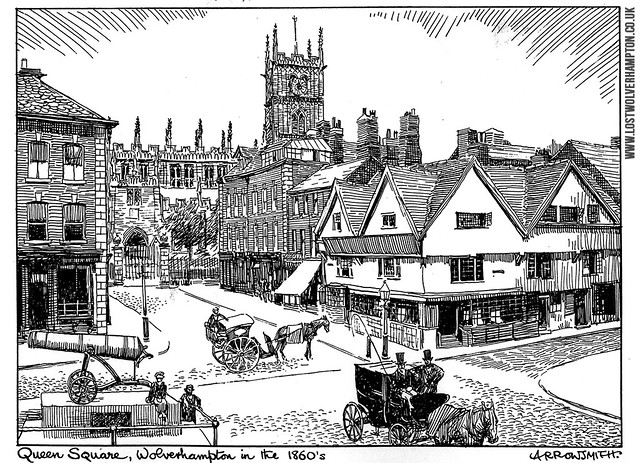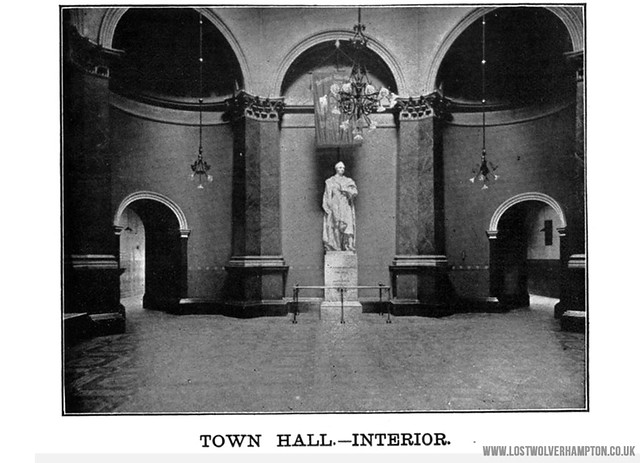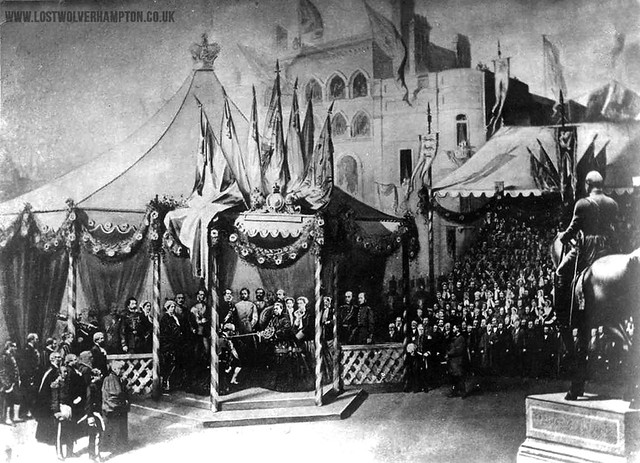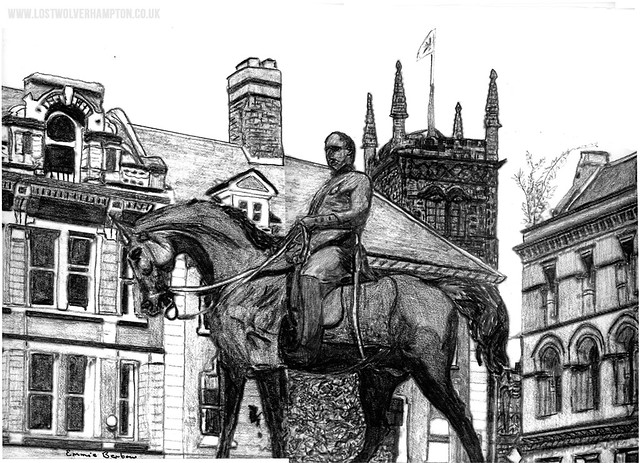
Wolverhampton’s “Man on the ‘Oss” is 150 years old this year!
Arrowsmith’s cartoon shows the captured Crimean Cannon, soon to be replaced with the statue of the Prince Consort which remains there today in 2015. After the death of Albert, the Prince Consort, in 1861 steps were taken in Wolverhampton to erect a statue in his memory.
In 1864 a meeting called by Alderman Underhill and attended by many eminent Gentlemen of the town, expressed its support for such a project and elected a committee of Subscribers to take charge of finance and administration. They were also responsible for deciding that the monument should take the form of a statue of the Prince and the sculptor Thomas Thornycroft was commissioned to undertake the task.

Thornycroft had previously sculptured the statue of Alderman George Thorneycroft, Wolverhampton’s first Mayor, which is now in the old Town Hall.
Permission to erect the statue was granted by Queen Victoria and it was her expressed opinion that the Prince should be portrayed on horseback, dressed in full military uniform.
She even gave permission for Thorneycroft to borrow the Prince’s uniform for his model to wear. His favourite charger along with its gold saddle cloth was also loaned, so that its features could be closely studied.
The statue was completed on 1st October 1865, at a cost of £1150 which was met by private subscriptions and public funds it was then sent away to be cast in bronze.

The statues pedestal was erected on High Green (Queen Square) in August 1866 and the statue was positioned in November of the same year. It was decided by the committee that Queen Victoria should be invited to perform the unveiling although it was expected that she would refuse as she had declined to appear in public after the Prince’s death and had also refused similar invitations to unveil monuments to his memory in Liverpool and Manchester. On November 21st 1866, to everyone’s surprise Her Majesty accepted the invitation.
This gave the Council, who had decided on November 30th as the date of unveiling, just nine days to prepare for her visit. Why the Queen accepted this particular invitation is not certain, but it is generally believed that a letter of sympathy from the widows of Wolverhampton, after her husband’s death, so touched her that she felt this invitation should not be turned down.

A decorations Committee was hastily assembled and although they only had a short time before the Queen’s arrival, they managed to persuade the citizens of the town that only a united effort would transform its appearance into something worthy of the Queen’s visit.
The Queen arrived at Low-Level Station on November 30th 1866, and was greeted by the Mayor, Recorder, Lord Lieutenant and other local dignitaries.
The procession then made its way to a specially erected pavilion on High Green for the ceremony.

The Queen knights the Mayor Before the unveiling took place however, the Queen to the surprise of everyone, knighted the Mayor, John Morris This was followed by the unveiling. At a signal from Her Majesty, a cord was drawn by John Thorneycroft and the statue , in all its splendour was revealed. Over the years, many of the buildings surrounding the statue have either been altered of demolished; even the area itself has had its name changed from High Green to Queen Square.

The statue however still remains although it has been re-sited three or four times, once for the roadway alterations in 1951 and finally in 1990 as part of the pedestrianisation of Queen Square.
Today it is a focal point for many locals and visitors to the town. Hence, to locals, the saying “I’ll see you by the man on the ‘oss“, denotes the meeting place as Queen Square quite well.

The original horse’s reigns were made of leather and went missing during the VE day celebrations in May 1945.being replaced in 1991 with a set of reigns cast in metal. Regarding the sculpture itself. a rumour amongst local people that the sculptor committed suicide after the unveiling because he realised that the horses stance was wrong is totally untrue. He lived to a ripe old age and died of natural causes in 1885. The rumour can possibly be put down to an old folks tale, similar to those connected to various other statues around the country. People being People like like a good story.

DESCRIPTION
The statue is nine feet high and stands on a stone plinth made from Dartmoor granite. It was cast in bronze by Elkinton and Co. of Birmingham.
The pose is that of the Prince returning the salutations of the crowd whilst gently restraining his mount . The Prince is wearing a uniform of a Field Marshal with the ribbons of the order of the Garter draped over his top coat.
FURTHER READING
- Wolverhampton Chronicle Nov 30th 1866 ( Special Supplement).
- The Queen Victoria’s visit to Wolverhampton November 30th 1866.
- www.lostwolverhampton.co.uk
- Historic Buildings of Wolverhampton Courtesy Wolverhampton Archives.